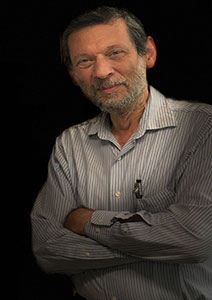Case Western Reserve biology, math researchers part of $3 million National Institutes of Health initiative to investigate how neurons work together to regulate movement
Case Western Reserve University researchers are part of an international team striving to crack the secrets of how our neurons—the nerve cells that send and receive signals to and from the brain—work together to regulate physical movements.
The work is supported by a $3 million grant from the National Institutes of Health Brain Research through Advancing Innovative Neurotechnologies (BRAIN) Initiative, a $1.3 billion interdisciplinary endeavor launched in 2014 to revolutionize our understanding of the human brain.

Case Western Reserve’s efforts will be spearheaded by Hillel Chiel, professor of biology, neurosciences and biomedical engineering, and Peter Thomas, professor of mathematics, applied mathematics and statistics.
Chiel’s contribution will expand on his decades-long work with the sea slug (Aplysia californica). Thomas will provide much of the mathematical modeling necessary to extrapolate what is learned from the sea slug’s neural activity to other species, including humans.
The researchers at Case Western Reserve and other labs also will use probes to measure and record the activity of individual neurons, as well as investigate how interneurons—neurons that send signals between sensory and motor movements—help in that process.
This project is being led by University of Texas researcher John Byrne. Others working with him, in addition to Case Western Reserve, are scientists from the University of Michigan, Icahn School of Medicine at Mount Sinai and Bar-Ilan University in Israel.
‘Persistent mysteries’

Thomas said one of the “persistent mysteries of neuroscience” is how our brains can change the way they respond to information, even in the midst of performing a task.
“Even the simplest brain is unlike a computer because it can adjust itself on the fly,” he said. “Imagine having a computer where the circuits literally change and rewire themselves in response to a new situation. The human brain is amazing, and we’re still working to understand it better.”
Chiel and Thomas said that while scientists have made great strides in recent years in understanding how single neurons work, far less is known about how they work together by the hundreds or thousands to actually cause us to move, react and anticipate.
“Really, our motor systems like feeding, walking and so on—the ‘how does it work?’ question—is still not solved,” Chiel said. “But science has shown us that the solutions you find in one animal, such as in the sea slug (which is far easier to analyze experimentally with far fewer neurons), also show up in other animals, even humans.”
Chiel studies the sea slug because it has only about 20,000 neurons—and only a few hundred controlling its tongue-like organ known as a grasper.
Humans, on the other hand, have billions of neurons working in their brains, making it very difficult to discern what neural activity is directly related to specific muscle movements, he said.
In this new project, Chiel will work with Cynthia Chestek, a University of Michigan scientist, who will provide microscopic, carbon-fiber probes to insert into the nerve cells of the sea slug to record, excite or inhibit activity.
Thomas will use the resulting data to create models to try to predict future behavior of the slug.
Possible impacts of research
Chiel said the knowledge could also someday help improve the effectiveness of cortical implants to benefit human patients, “though that’s still some time in the future,” he said.
University of Texas researchers also hope the data from this work could help solve neurological disorders that are impacted by neuron circuits, including schizophrenia, autism spectrum disorders, attention-deficit hyperactivity disorder and memory diseases such as Alzheimer’s disease.
This new work could also have an impact on the robotics research being done by Case Western Reserve colleagues Roger Quinn, the Arthur P. Armington Professor of Engineering and director of the Biorobotics Complex at the Case School of Engineering, and Kathryn Daltorio, assistant professor of mechanical and aerospace engineering. “A robot is really just a way of creating a physical model,” Chiel said. “So, the more we understand about flexible nervous systems and bodies, the more we’re able to create more flexible and adaptive robotic devices.”
For more information, contact Mike Scott at mike.scott@case.edu.

